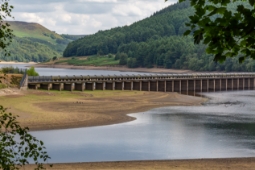Red oak (ROK)
A fast-growing, non-native broadleaved tree that produces timber with good wood properties and has attractive autumnal colour. There are currently 852 ha of the species in Britain, and it could find an increased role on drier soils in the south and east of the country as a result of climate warming. One of a number of red oak species a number of which have shown positive traits as specimens or in limited plot trials and warrant further research.
Red oak is categorised as a secondary tree species. These are tree species that have demonstrated positive silvicultural characteristics in trial plots, but gaps in knowledge constrain wider use. The species are being actively evaluated to increase understanding and inform future deployment.




Range
Native to eastern North America and a long-standing plantation species in the Netherlands, Belgium and northern France.
Provenance Choice
Initial results from provenance trials in England indicate that seed should be sourced from southern Canada. Experience has also shown good stands in north-western Europe produce seed suitable for use in Britain.
Key Properties
Site Requirements
Red oak is fully cold hardy in Britain and is widely planted as a specimen tree for its autumn foliage colour. Best suited to moderately dry to moist soils of poor to medium nutrient status and outgrows native oaks on acid sandy loams. The species is windfirm and moderately tolerant of exposure and drought.
Further detail on the site requirements of red oak in current and future climates can be examined using the Forest Research Ecological Site Classification Decision Support System.
ECOLOGICAL SITE CLASSIFICATION TOOL
Silviculture
Red oak should be planted at densities similar to native oaks if timber production is a management objective, i.e. a minimum of 3100 stems per hectare for new planting and 2500 for restocking.
With good establishment practice initial growth can be rapid and it will establish quickly.
The species is intermediate in shade tolerance when young, but loses tolerance quickly and is a light demander when semi-mature. It will produce seed at 20-25 years (40-50 years reliably) under the right conditions and will naturally regenerate, but seedlings are unlikely to survive under a full canopy.
Epicormic branches are not considered an issue with red oak and the crowns will respond well to thinning. Management should select 100 future crop trees per hectare early in the life of the crop and then apply crown thinning to ensure rapid diameter increment of the selected trees. Using this approach should produce a target 60 cm DBH in 70-90 years depending on site quality.
Red oak typically out-performs native oaks by one or two yield classes on dry sandy soils with GYC 6-8 typical, and occasionally GYC 10 after 40-75 years. The species coppices readily with good light and when protected from browsing; anecdotal observations would suggest growth similar to sweet chestnut on appropriate sites.
Pests and Pathogens
Red oak is susceptible to Phytophthora and is probably best avoided where infected larch has recently been grown. Honey fungus (Armillaria) can also affect red oak, especially when weakened by drought or other causes. Oak processionary moth might affect red oak in a similar manner to native oaks. The susceptibility to acute oak decline has not been established. Red oak is prone to grey squirrel damage and very palatable to deer and other browsing mammals.
See our other tools and resources
Further Resources
Internal
In addition to the general sources of information for species the following are useful for red oak.
External
In addition to the general sources of information for species the following are useful for red oak.
Dey, D., and Buchanan, M. 1995 Red oak (Quercus rubra L.) acorn collection, nursery culture and direct seeding: a literature review. Ontario Ministry of Natural Resources, Ontario Forest Research Institute, Sault Ste. Marie, Ontario, Forest Research information Paper No. 122, 46p.
Nicolescu, V. et al. 2020 Ecology and management of northern red oak (Quercus rubra L. syn. Q. borealis F. Michx.) in Europe: a review. Forestry, 93(4): 481-494
USDA 2019, Quercus rubra L., United States Department of Agriculture; Natural Resources Conservation Service, viewed 16 July 2020, <https://plants.sc.egov.usda.gov/core/profile?symbol=QURU>
Wilson, S., Mason, W., Savill, P. and Jinks, R. 2018 Alternative oak (Quercus spp.). Quarterly Journal of Forestry, 112(2): 93-105.




